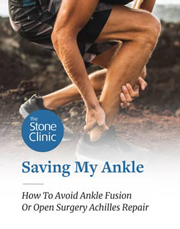Don’t Open the Achilles
The ruptured Achilles tendon heals beautifully when repaired. It just doesn’t need open surgery to repair it. Here is why.

The Achilles is a broad tendon that connects the calf muscles to the heel. The tendon is covered in a thin but important sheath of tissue that permits it to contract and lengthen smoothly with each step. This sheath, or synovium, is a layer of specialized cells that provides lubrication and nutrition to the tendon. When the sheath is injured, problems arise.
Tendonitis often starts with the inflammation and swelling of that sheath. The inflamed cells multiply rapidly, producing excess fluid. Within that fluid is a mixture of degradative and anabolic enzymes as well as growth factors. Sometimes there is noticeable cracking as the tendon slides, no longer smoothly, through the thickened passageway. When out of control, the inflammation leads to thickening and scarring of the sheath and a breakdown of the fibers of the tendon itself. Over time, this process of inflammation may heal—or it may lead to chronic degeneration, with the death of isolated areas of the tendon fibers. This story is true not only for the Achilles, but also for chronic tendonitis of the elbow (tennis elbow), the patella (housemaid’s knee), or the rotator cuff (pitcher’s shoulder).
Ruptures of the Achilles tendon are often preceded by a period of tendonitis. The tendon hurts for a while and inflammation weakens the tissue. Rupture sometimes occurs after landing from a jump on a basketball court (e.g., Kevin Durant) or lunging for a shot on a tennis court.
If treated early, inflammation caused by tendonitis subsides and the normal repair cells and growth factors of the body heal the injury. The same is true for Achilles tendon ruptures. Here is what happens: The fibers of the tendon tear within the synovium. Immediately upon tearing, blood rushes to the site of injury, bringing with it the body’s repair cells (stem, progenitor, and other specialized cells). Massive amounts of growth factors are released at the injury site, with the repair process directed by those specialized cells. A blood clot (hematoma) forms within the sheath and the healing process begins.
If left alone, the Achilles will heal—but since the tendon fibers have been pulled apart, the healing that does occur leaves the tendon somewhat longer and weaker than it was before the injury. Thus, most people choose to have the tendon repaired.
This is where the debate begins. If a surgeon opens the synovium with an incision, the tendon ends can then be sutured together—but all of the growth factors in the healing hematoma are lost. The thin sheath cannot be closed and must reform on its own over time. Scar tissue builds up during that process and the subsequent healing takes up to a year—not to heal the tendon, but to recover from the surgical insult.
If the surgeon employs the percutaneous techniques that have been refined over the last three decades, sutures can be placed into the proximal end of the tendon tear through tiny skin nicks, woven beneath the skin and through the sheath to the distal end, and then pulled together. This technique—originally developed by Ma and Griffiths in 1977, and refined by us and others—allows the Achilles to heal with its normal length, much less scar tissue, and no open incision. It, therefore, preserves the vast natural growth factors and cells and promotes complete recovery. The process is now augmented further with the application of additional growth factors, immediate rehabilitation programs (with daily soft-tissue massage), and a well-defined strengthening program.
So while you may hear of top athletes having open surgery on their ruptured Achilles—followed by daily laser and other dubious procedures to increase blood flow and reduce the surgical scarring—shake your head. Such stories defy both logic and science.

